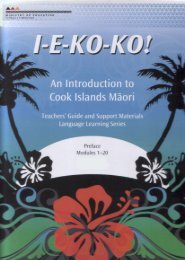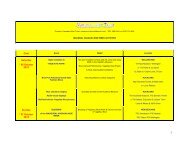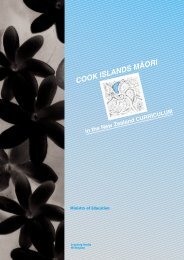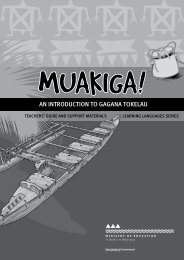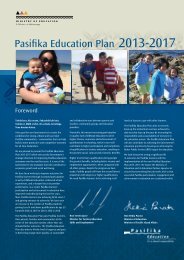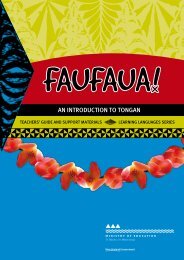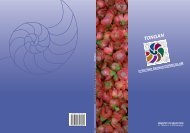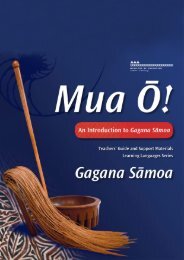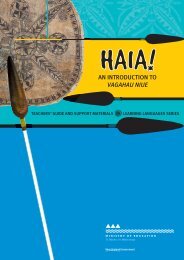Ta'iala mo le Gagana SÄmoa - Pasifika Education Community
Ta'iala mo le Gagana SÄmoa - Pasifika Education Community
Ta'iala mo le Gagana SÄmoa - Pasifika Education Community
You also want an ePaper? Increase the reach of your titles
YUMPU automatically turns print PDFs into web optimized ePapers that Google loves.
Poto i <strong>le</strong> <strong>Gagana</strong>Language Know<strong>le</strong>dgeVocabulary and grammatical structures are the building blocks for developing the language know<strong>le</strong>dge(oral, spoken, and visual) that builds <strong>le</strong>arners’ proficiency in using gagana Sā<strong>mo</strong>a in a range of contexts.Learning vocabulary and grammatical structures is a cumulative process, which usually involves <strong>le</strong>arningsimp<strong>le</strong> structures first and progressing to <strong>le</strong>arning comp<strong>le</strong>x ones. For examp<strong>le</strong>, <strong>le</strong>arners of gagana Sā<strong>mo</strong>ausually understand the construction Sau ‘i totonu (Come inside) before the construction Sau ‘i totonu‘auā ‘ua mālūlū (Come inside because it’s cold).However, in many com<strong>mo</strong>n situations and contexts, <strong>le</strong>arners may need to be ab<strong>le</strong> to use some formulaicexpressions that are relatively grammatically comp<strong>le</strong>x. These include greetings and responses such as‘O ā mai ‘oe? (How are you?) and Manuia fa‘afetai (Fine, thank you). Formulaic expressions can be<strong>le</strong>arned in context as “chunks” of language. Learners will come to understand their grammaticalstructure when they gain enough know<strong>le</strong>dge and experience of the language to be ab<strong>le</strong> to ref<strong>le</strong>ct onhow it is structured.It is best to teach and <strong>le</strong>arn vocabulary and grammatical structures within meaningful, realistic contexts.For examp<strong>le</strong>, teachers could introduce the question form E to‘afia tagata i lou ‘āiga? (How many peop<strong>le</strong>in your family?) when students are discussing their families.16Learners become competent in grammar by interacting frequently in meaningful ways. They need p<strong>le</strong>ntyof opportunities to practise what they are <strong>le</strong>arning so that eventually they can use gagana Sā<strong>mo</strong>a tocommunicate spontaneously. Teachers need to revisit language structures over time to ensure that<strong>le</strong>arners have opportunities to reinforce prior <strong>le</strong>arning. By continuously recycling and consolidating theirknow<strong>le</strong>dge of grammatical structures, <strong>le</strong>arners can acquire new structures when they are ready.It is important for teachers to remember that <strong>le</strong>arners acquire know<strong>le</strong>dge of the language systemprogressively. In the initial stages, <strong>le</strong>arners may produce approximations (that is, forms that are al<strong>mo</strong>stbut not quite correct) of a given grammatical structure. These approximations are often stepping stonesto acquiring the correct forms. Learners can use these forms to communicate effectively to some degree,even when they have very limited know<strong>le</strong>dge of the language’s structure. Although it is natural forlanguage <strong>le</strong>arners to make mistakes, they should receive feedback on how close their approximations areto the target, keeping in mind that effective communication is the key criterion.Finding a productive balance between encouraging <strong>le</strong>arners to communicate spontaneously andcorrecting their errors is best. When <strong>le</strong>arners are conversing spontaneously, teachers may choose to allowsome mistakes, where appropriate. This will allow the conversation to flow and will help <strong>le</strong>arners to gainconfidence and use the language willingly. As students progress through the <strong>le</strong>vels, they will <strong>le</strong>arn tocommunicate <strong>mo</strong>re accurately, just as small children do when <strong>le</strong>arning their first language. They willbecome increasingly aware that accuracy of expression, as well as fluency, is needed for really effectivecommunication in oral, written, and visual texts.



